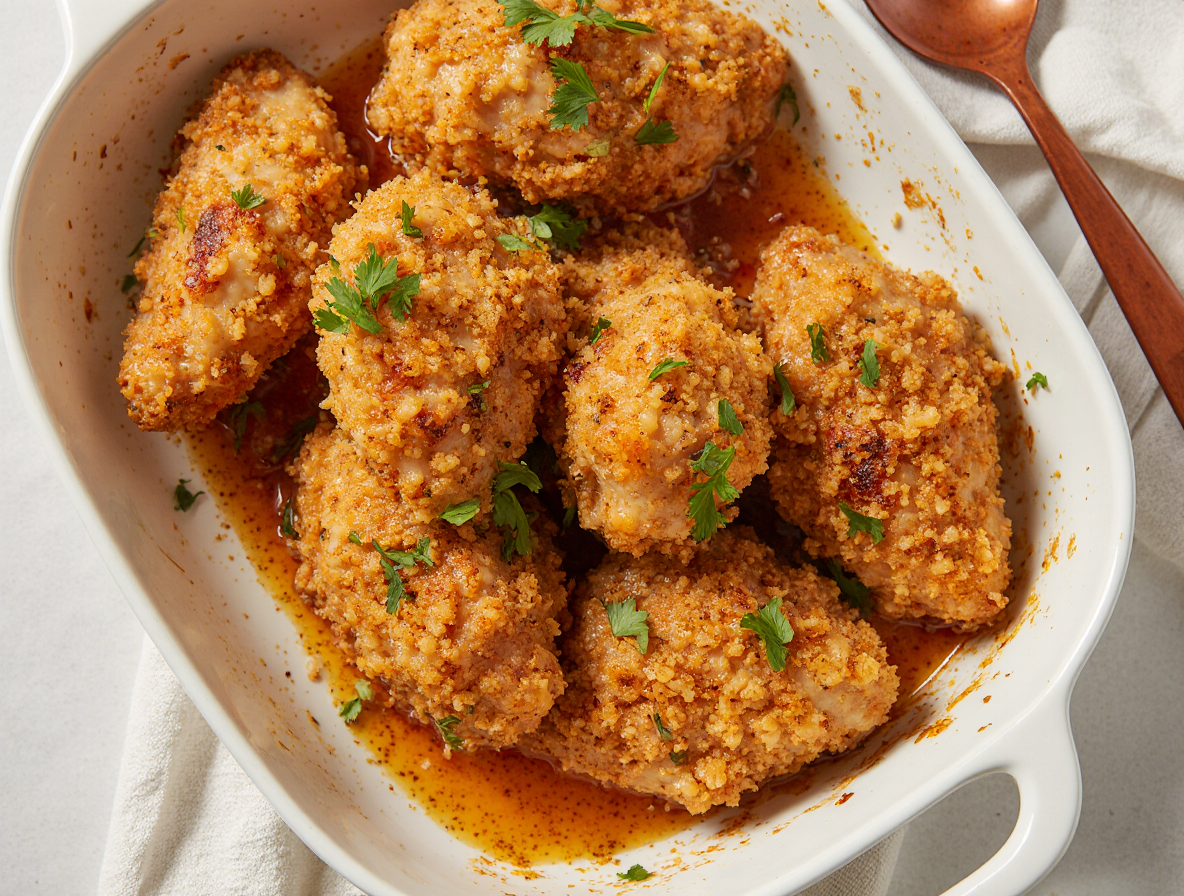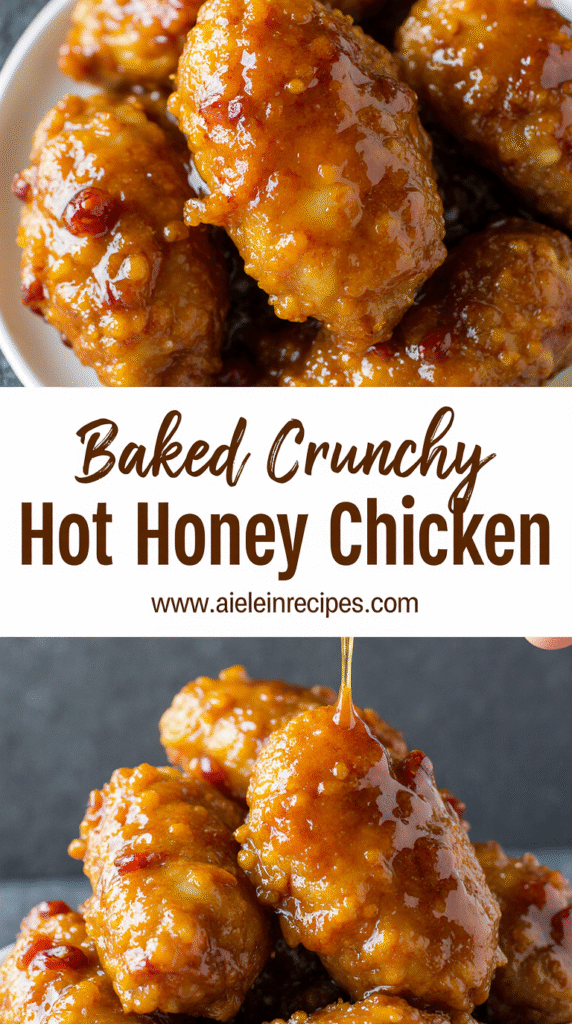Perfect Baked Crunchy Hot Honey Chicken: A Foolproof Guide
Baked crunchy hot honey chicken delivers that perfect golden crunch without the guilt of deep frying. While many assume crispy chicken requires a vat of oil, I’ve discovered that the oven can work wonders—especially when you know the right techniques. Taking only 25 minutes from start to finish, this dish has become my go-to for everything from family dinners to game day snacks.
What makes this hot honey chicken recipe truly special is the combination of a flavorful spice mix and the secret weapon—crushed cornflakes that provide that irresistible crunch. Additionally, the hot honey sauce for chicken creates the perfect balance of sweet and spicy that keeps everyone coming back for more. At just 403 calories per serving, this crispy hot honey chicken is both satisfying and relatively guilt-free. Throughout this guide, I’ll walk you through how to achieve perfectly crunchy hot honey chicken that’s baked to a golden brown with an internal temperature of 165°F, ensuring it’s both delicious and safe to eat.
Choosing the Right Ingredients for Crunch and Flavor
The success of your baked crunchy hot honey chicken begins with selecting the proper ingredients. The right combination of chicken cuts, coating, and seasonings creates that perfect balance of juicy meat with an irresistible crispy exterior.
Best chicken cuts for baking
Boneless skinless chicken breasts remain a popular choice for baked chicken recipes due to their lean nature and quick cooking time. However, if you’re seeking more moisture, boneless skinless chicken thighs provide a juicier alternative without risking the coating burning during the extended cooking time. For those who prefer chicken strips, consider using actual chicken tenders—the strip of meat located underneath the breast that’s slightly more tender than the breast itself. Regardless of which cut you choose, pounding the chicken to an even thickness (about 1.5cm/0.6″) is crucial for even cooking and tenderness.
Why cornflakes make the perfect crust
Cornflakes create that signature crunch that makes this dish stand out. Unlike regular breadcrumbs, cornflakes provide a lighter, airier texture that stays crispy. Furthermore, their larger size means they don’t absorb as much moisture during baking, maintaining that satisfying crackle with each bite. For the best results, crush the cornflakes to the right consistency—not too fine, as you want to preserve those larger flakes that create texture.
Spices that enhance the flavor
A simple yet effective spice blend brings your hot honey chicken recipe to life. Notably, a combination of:
- Paprika (1 tsp) adds color and subtle sweetness
- Garlic powder (½ tsp) and onion powder (½ tsp) provide savory depth
- Salt (1 tsp) and black pepper (¼ tsp) for basic seasoning
- Cayenne pepper (⅛ tsp) gives a touch of heat
You can certainly customize your spice blend based on personal preference. In fact, some cooks add dried herbs like thyme, oregano, or basil (1 tsp each) for additional flavor dimensions.
Optional add-ins like parmesan or herbs
Freshly grated Parmesan cheese makes an excellent addition to your breading mixture. Primarily, it melts better than pre-grated varieties and creates a golden-brown crust when baked. For herbaceous notes, incorporate fresh herbs when possible as they provide more vibrant flavors than their dried counterparts. Fresh parsley works wonderfully as a garnish, adding brightness to the finished dish. Alternatively, fresh rosemary (1 tsp) and thyme leaves (2 tsp) complement the savory profile of crispy hot honey chicken.
Step-by-Step Guide to Breading and Baking
Achieving the perfect crunchy exterior for your baked hot honey chicken starts with mastering the breading technique. Properly set up your workspace, and that golden coating will be both delicious and picture-perfect.
Setting up your dredging stations
The foundation of a good breading process lies in organization. First, arrange your supplies in shallow dishes from left to right: raw chicken, seasoned flour, beaten egg (or egg wash), and your final coating. This assembly-line approach ensures efficiency and less mess. Pat the chicken completely dry before starting—excess moisture prevents proper adhesion and leads to soggy results. Moreover, season both your dredge and final coating generously with salt, pepper, and spices for layers of flavor throughout.
How to double coat for extra crunch
Single breading can fall off easily and get soggy faster compared to a thicker crust. To achieve that restaurant-quality crispiness, try double dredging: coat the chicken in flour, dip in egg wash, return to flour, then back into egg wash, and finally into the coating one last time. Subsequently, press the coating firmly onto the chicken—this step is crucial for helping it stick through the baking process. Consider mixing buttermilk with your egg wash (one tablespoon per egg) for a tangier shell that adheres better.
Tips for even baking and crispiness
Preheat your oven to 400-425°F along with a dark-colored pan, which conducts heat better for superior crisping. For optimal results, place the chicken on a wire rack inside your baking sheet—this creates airflow underneath for even cooking. After baking, allow the chicken to rest 2-3 minutes before serving, but not longer as it will start getting soggy. For that extra crunch, switch the oven to broil for the final 1-2 minutes, watching carefully to prevent burning.
Oven vs air fryer: what works best
Although both appliances use circulated hot air, an air fryer consistently produces crispier results than a conventional oven. The air fryer’s smaller interior and more powerful airflow create a perfectly crispy exterior while maintaining juicier meat inside. Perhaps most impressively, it achieves these superior results in significantly less time. In a direct comparison test using identical breaded chicken, the air fryer swept all categories—crispier coating, juicier interior, and faster cooking time.
Making the Perfect Hot Honey Sauce
The hot honey sauce is what elevates your baked crunchy chicken from ordinary to extraordinary. This sweet-spicy elixir adds complexity and excitement to each bite, making it worth perfecting.
Basic hot honey sauce ingredients
The foundation of any hot honey sauce starts with quality honey. Raw honey provides better flavor than processed varieties that often contain added sugar. For the heat component, most recipes rely on either hot sauce (like Frank’s RedHot or Louisiana) or dried red pepper flakes. Some chefs enhance their sauce with additional elements such as:
- Butter (2-3 tablespoons) for richness and body
- Apple cider vinegar (2 teaspoons to 1/3 cup) for tanginess
- Garlic powder (1/2 teaspoon) and onion powder (1/2 teaspoon) for depth
- Smoked paprika (1/2 teaspoon) for subtle smokiness
Balancing sweet and spicy
The ideal hot honey sauce delivers a slow-building heat rather than an overwhelming burn. According to experts, you can easily adjust the spice level by increasing or decreasing the cayenne pepper. For milder sauce, reduce cayenne by 1 teaspoon; for more intensity, add an extra teaspoon. Alternatively, consider varying your peppers—jalapeños offer moderate heat, whereas habaneros provide significant spice.
How to thicken or thin the sauce
To create the perfect consistency, combine all ingredients in a small saucepan over medium-low heat. Stir occasionally until the honey warms and becomes infused with spices, typically 10-15 minutes. Be careful not to boil the mixture, as this can alter the flavor. For a thicker sauce, simply simmer longer to reduce the liquid, whereas adding a splash of apple cider vinegar helps thin it out.
When and how to drizzle for best results
Timing matters with hot honey sauce. For maximum impact on baked crunchy hot honey chicken, drizzle the sauce generously after the chicken has finished baking. Apply approximately one cup of sauce, then gently turn the pieces and apply another cup. Offering additional sauce on the side allows guests to customize their heat level according to preference. Remember that the sauce will continue developing flavor as it sits, becoming spicier over time.
Common Mistakes and How to Avoid Them
Even experienced cooks encounter challenges when making baked crunchy hot honey chicken. Let’s explore common pitfalls and their solutions.
Why your coating might fall off
The primary reason breading separates from chicken is excess moisture. First, thoroughly pat the chicken dry with paper towels before starting the breading process. Chilling the breaded chicken for 30-40 minutes before cooking helps the coating set up properly. Insufficient flour beneath your egg wash creates a weak foundation—ensure you have a thin but complete coating of flour, removing any excess. After applying the final coating, gently pat it down on all sides to help every layer adhere properly.
Avoiding soggy chicken
To maintain crispiness, place your chicken on a wire rack inside your baking sheet—this allows air to circulate underneath. For recipes with sauce, instead of pouring liquid directly onto the chicken, spread it around the meat in a circle to preserve the crispy texture. Dark, non-stick pans heat to higher temperatures than light-colored ones, consequently producing crispier results. When serving, avoid covering the hot chicken as trapped steam creates sogginess; instead, keep it warm in a 225°F oven until ready to eat.
Overbaking and drying out the meat
The most common mistake leading to dry chicken is overcooking. For perfect doneness, chicken should reach an internal temperature of 165°F—anything higher results in tough, dry meat. Cooking at lower temperatures (around 300°F) for longer periods helps chicken cook evenly without drying out. For bone-in cuts, the hollow structure of bones acts as an insulator against overcooking. Allow chicken to rest after cooking (5-10 minutes for breasts or thighs) so moisture redistributes throughout the meat.
Fixing a sauce that’s too spicy
If your hot honey sauce becomes too fiery, dairy products containing casein effectively neutralize heat—try adding heavy cream, yogurt, or butter. Under those circumstances where dairy isn’t ideal, incorporate something sweet like honey or maple syrup. High-fat ingredients such as nut butters help dissolve capsaicin oils, reducing their heat impact. As an alternative approach, dilute the sauce by adding more of the non-spicy ingredients or a splash of acidic components like lemon juice or vinegar.
Conclusion
Making perfect baked crunchy hot honey chicken certainly doesn’t require professional culinary skills. Throughout this guide, we’ve discovered how to achieve that golden crunch without submerging chicken in oil. The secret lies in carefully selected ingredients, proper breading techniques, and knowing the little tricks that make all the difference.
Cornflakes stand out as the hero ingredient, providing that distinctive crunch that regular breadcrumbs simply can’t match. Additionally, our spice blend creates layers of flavor that complement the sweet-heat balance of the hot honey sauce. This combination delivers restaurant-quality results right from your home oven.
Remember that proper preparation prevents many common issues. Patting the chicken dry, setting up an organized dredging station, and double-coating will help your breading stay put. Similarly, using a wire rack during baking allows air circulation for maximum crispiness.
The hot honey sauce deserves special attention because it transforms this dish from good to unforgettable. You can easily adjust its heat level to suit your preference while maintaining that perfect balance of sweet and spicy flavors.
After trying this recipe, you’ll likely find yourself making it repeatedly. The relatively low calorie count (just 403 calories per serving) makes it a healthier alternative to traditional fried chicken. Best of all, this dish works for almost any occasion – family dinners, game day gatherings, or casual entertaining.
So next time you’re craving that satisfying crunch of fried chicken without the guilt, grab some cornflakes and honey. Your taste buds will thank you for this perfect combination of crispy exterior, juicy meat, and that irresistible sweet-spicy glaze. This foolproof method proves that baked chicken can indeed rival its deep-fried counterpart!
FAQs
Q1. How can I achieve extra crispy baked chicken? For extra crispy baked chicken, use crushed cornflakes instead of breadcrumbs, double-coat the chicken, and bake on a wire rack. Preheat the oven to 400-425°F and consider using a dark-colored pan for better heat conduction. You can also broil for the final 1-2 minutes for an extra crispy finish.
Q2. What’s the secret to making the perfect hot honey sauce? The perfect hot honey sauce combines quality raw honey with hot sauce or red pepper flakes. Balance sweetness and heat by adjusting the amount of cayenne pepper. For added depth, include ingredients like butter, apple cider vinegar, and spices. Simmer the mixture on low heat for 10-15 minutes to infuse flavors without boiling.
Q3. Why does my breading fall off during cooking? Breading may fall off due to excess moisture on the chicken. To prevent this, pat the chicken dry before breading, ensure a thin but complete flour coating, and chill the breaded chicken for 30-40 minutes before cooking. Also, gently pat down the final coating to help it adhere properly.
Q4. How can I prevent my baked chicken from becoming soggy? To avoid soggy chicken, use a wire rack inside your baking sheet for air circulation. When adding sauce, spread it around the meat instead of pouring it directly on top. Use dark, non-stick pans for crispier results, and avoid covering hot chicken as it traps steam.
Q5. What’s the best way to fix an overly spicy hot honey sauce? If your hot honey sauce is too spicy, try adding dairy products like heavy cream or butter to neutralize the heat. Alternatively, incorporate something sweet like honey or maple syrup. You can also dilute the sauce by adding more non-spicy ingredients or a splash of lemon juice or vinegar.


